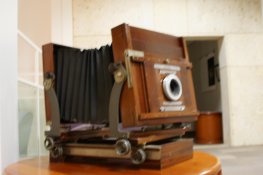From US-Army documentation it is clear that the mainstay of camera equipment was made up by
Speed Graphics especially this type (PH-47):
http://www.speedgraphic.fr/PH-47E_UK.html
In 35mm it was the
Kodak 35 in military version (olive-green outer and click-stop aperture):
Dead Link Removed
Later a special designed camera was used (PH-501):
http://www.peterlanczak.de/simmon_combatcamera.htm
In small quantities
Leicas and
Rolleiflexes were stated to be used, bought off the shelves or 2nd hand. Though not modified and though not the standard cameras these two, as the two above, were put into type-related, designated camera kits.
Also private owned cameras were used by photographers when they considered them superior to the standard one. (Zeiss Super Ikonta B above the standard Speed Graphic)












